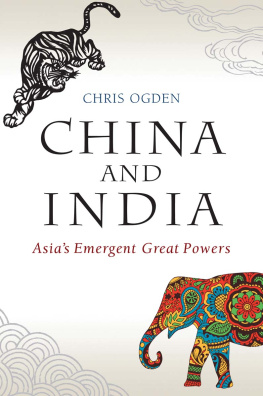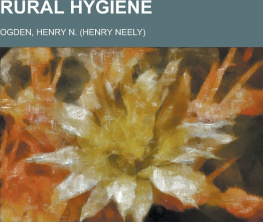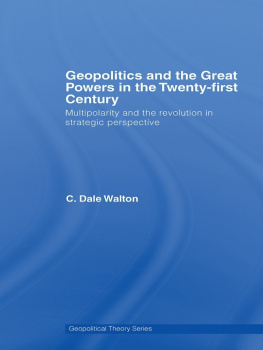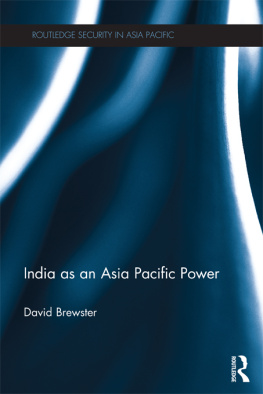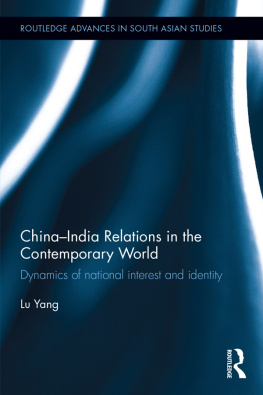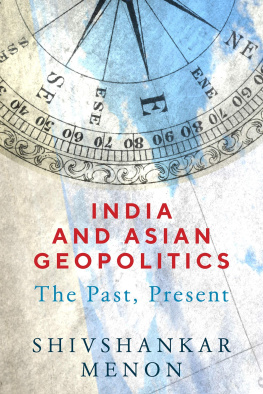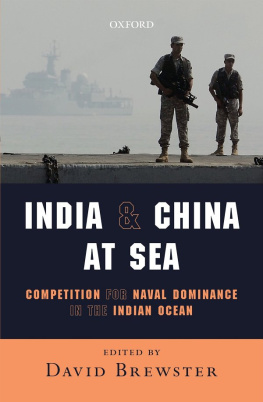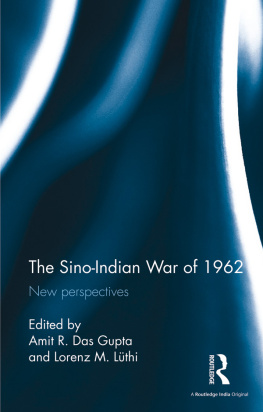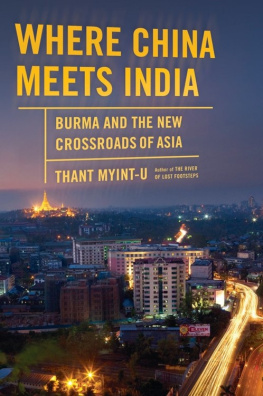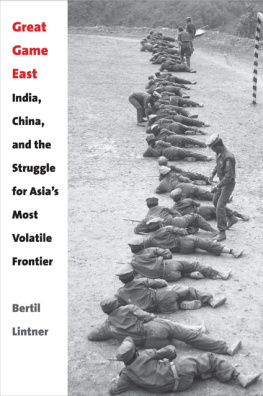Contents
Tables
Guide
Pages

For my sisters: two of lifes other great powers
China and India
Asias Emergent Great Powers
Chris Ogden
polity
Copyright Chris Ogden 2017
The right of Chris Ogden to be identified as Author of this Work has been asserted in accordance with the UK Copyright, Designs and Patents Act 1988.
First published in 2017 by Polity Press
Polity Press
65 Bridge Street
Cambridge CB2 1UR, UK
Polity Press
350 Main Street
Malden, MA 02148, USA
All rights reserved. Except for the quotation of short passages for the purpose of criticism and review, no part of this publication may be reproduced, stored in a retrieval system or transmitted, in any form or by any means, electronic, mechanical, photocopying, recording or otherwise, without the prior permission of the publisher.
ISBN-13: 978-0-7456-8990-6
A catalogue record for this book is available from the British Library.
Library of Congress Cataloging-in-Publication Data
Names: Ogden, Chris (Christopher), author.
Title: China and India : Asias emergent great powers / Chris Ogden.
Description: 1 | Cambridge, UK ; Malden, MA : Polity, 2017. | Includes bibliographical references and index.
Identifiers: LCCN 2016038445 (print) | LCCN 2016059761 (ebook) | ISBN 9780745689869 (hardback) | ISBN 9780745689876 (paperback) | ISBN 9780745689890 (Mobi) | ISBN 9780745689906 (Epub)
Subjects: LCSH: China--Foreign relations--21st century. | China--Military policy. | Strategic culture--China. | India--Foreign relations--21st century. | India--Military policy. | Strategic culture--Inida. | BISAC: POLITICAL SCIENCE / Globalization.
Classification: LCC JZ1734 .O44 2017 (print) | LCC JZ1734 (ebook) | DDC 327.51--dc23
LC record available at https://lccn.loc.gov/2016038445
The publisher has used its best endeavours to ensure that the URLs for external websites referred to in this book are correct and active at the time of going to press. However, the publisher has no responsibility for the websites and can make no guarantee that a site will remain live or that the content is or will remain appropriate.
Every effort has been made to trace all copyright holders, but if any have been inadvertently overlooked the publisher will be pleased to include any necessary credits in any subsequent reprint or edition.
For further information on Polity, visit our website: politybooks.com
ABBREVIATIONS
AIIBAsian Infrastructure Development BankASEANAssociation of Southeast Asian NationsBJPBharatiya Janata PartyBRICSBrazilRussiaIndiaChinaSouth Africa [grouping]CAFTAChinaASEAN Free Trade AgreementCCPChinese Communist PartyCMACCentral Military Affairs Commission (China)CTBTComprehensive Test Ban TreatyCYLCCommunist Youth League of ChinaDPRKDemocratic Peoples Republic of KoreaEEZexclusive economic zoneFDIforeign direct investmentGATTGeneral Agreement on Tariffs and TradeGDPgross domestic productIAFIndian Air ForceIBSAIndiaBrazilSouth Africa Dialogue ForumIMFInternational Monetary FundINCIndian National CongressIORIndian Ocean RegionIRinternational relationsLoCLine of ControlMEAMinistry of External Affairs (India)MoFAMinistry of Foreign Affairs (China)NAMNon-Aligned MovementNDBNew Development BankNFUno first useNIEONew International Economic OrderNPT[Nuclear] Non-Proliferation TreatyNSANational Security Adviser (India)NSCNational Security Council (India)P5Permanent Five [UN Security Council Veto Members]PAPPeoples Armed Police (China)PLAPeoples Liberation Army (China)PLANPeoples Liberation Army Navy (China)PMOPrime Ministers Office (India)PPPprice purchasing parityPRCPeoples Republic of ChinaRMBrenminbiSAARCSouth Asian Association for Regional CooperationSCOShanghai Cooperation OrganizationSOEstate-owned enterpriseUNPKOsUnited Nations Peacekeeping OperationsWTOWorld Trade Organization
ACKNOWLEDGEMENTS
It has been a pleasure to work again with Louise Knight at Polity on this project, with the capable assistance of Nekane Tanaka Galdos (and her predecessor Pascal Porcheron). I am grateful to Louise for her timely and erudite editorial advice, along with that of the various anonymous reviewers who provided valuable and discerning comments during the books formative stage. I also wish to thank my postgraduate and undergraduate students in the School of International Relations at the University of St Andrews (variously taking IR3046, IR4528, IR4545 and IR5040), who via our fervent discussions and arguments over the last five years helped to critically gestate some of the key ideas present in this book, as well as Jascha Zittel, who carried out the initial literature review underpinning the volume. Finally, thank you to Sally Cummings, who back in 2010 initially planted the idea of comparing China and India as emergent great powers.
Edinburgh, September 2016
INTRODUCTION: GREAT POWER AND THE RISE OF CHINA AND INDIA
China and Indias contemporary rise to prominence will significantly impact upon geopolitics over the coming decades. Providing a comparative analysis of their shared emergence as great powers within the international system, this book evaluates the impact of Asias two largest powers upon the definition, delineation and nature of power politics. Focusing upon the factors integral to such a phenomenon (from both historical and theoretical perspectives), and through a wide-ranging analysis of our understanding/definition of great power, we will build up a comprehensive and detailed understanding of these two states past, contemporary and future global significance. With their world-leading economic prowess, mounting military expenditures and increasingly heard and sought after diplomatic voices, both China and India are resolutely on the rise. As a key dimension of present-day international politics, it is the shared emergence of these two immense states that is also of particular significance, especially their geographical presence within the same if highly complex world region that is Asia. Their simultaneous analysis therefore not only provides us with an appreciation of their similarities and differences as they endeavour to fulfil a common goal, but also helps us to determine what great power represents and symbolizes in the twenty-first century a century that appears set to be largely Asia-dominated and Asia-centric.
Within traditional Western paradigms, India and China are often expected to rise in much the same way as the current and previous great powers, primarily via the accumulation of traditional material and military measures. This volume strongly contends, however, that domestic political/cultural values and historical identities are central driving forces behind their mutual status ambitions and worldviews. Indicating as it does that both states will necessarily follow their own unique pathways to achieving great power status, the book argues that how their elites understand and then attempt to realize such a vision gains ever greater importance. With the current presence of ardently nationalist leaders in both China and India, in the form of, respectively, Xi Jinping and Narendra Modi, the acquisition of such a status, and the respect and esteem that it brings, is being openly pursued. Through regular exhortations, these leaders (and their many predecessors, if somewhat more reservedly) have declared their states to be in the worlds top tier, with a global significance that cannot be ignored, and that they just as other great powers have done will shape our world. In turn, as our analysis will show, both India and China envisage a multipolar world order of several great powers, a perspective that differs from the common Western view of a dominant hegemon. At its core, this vision innately threatens the continued global dominance of the United States.

